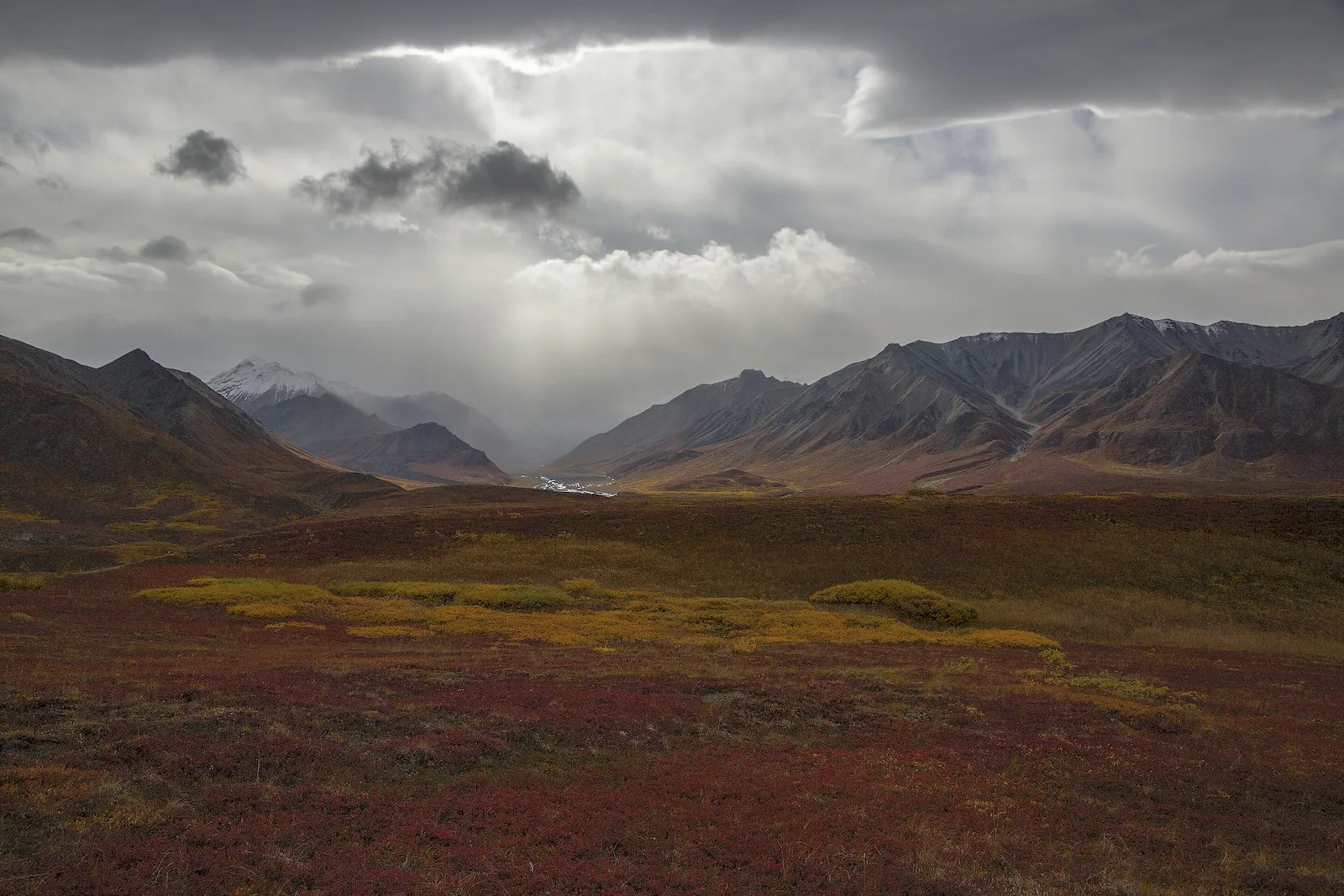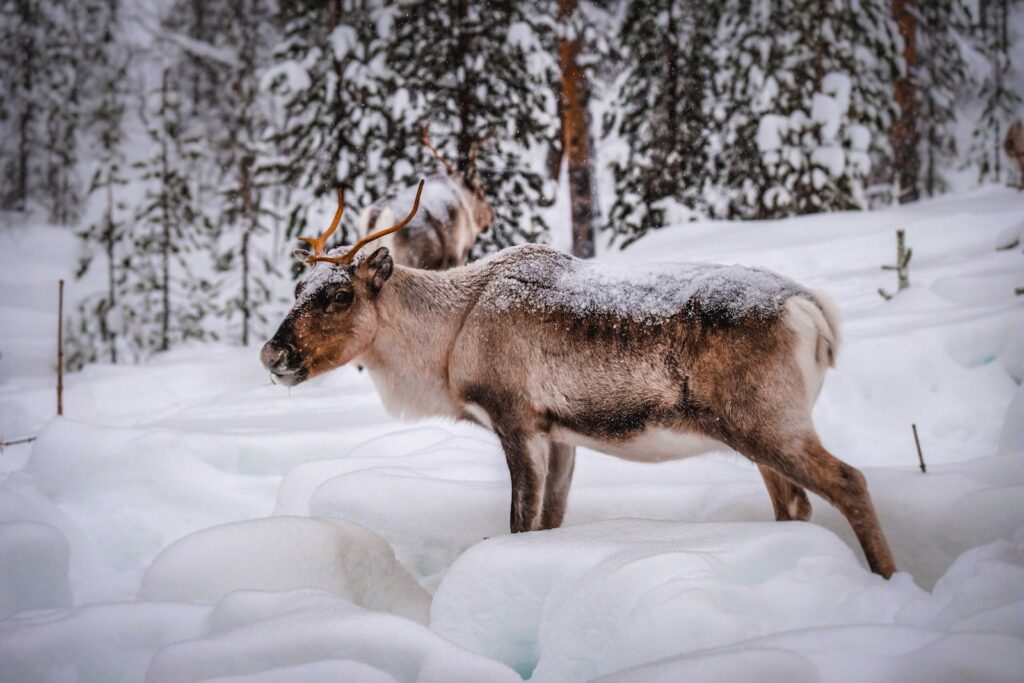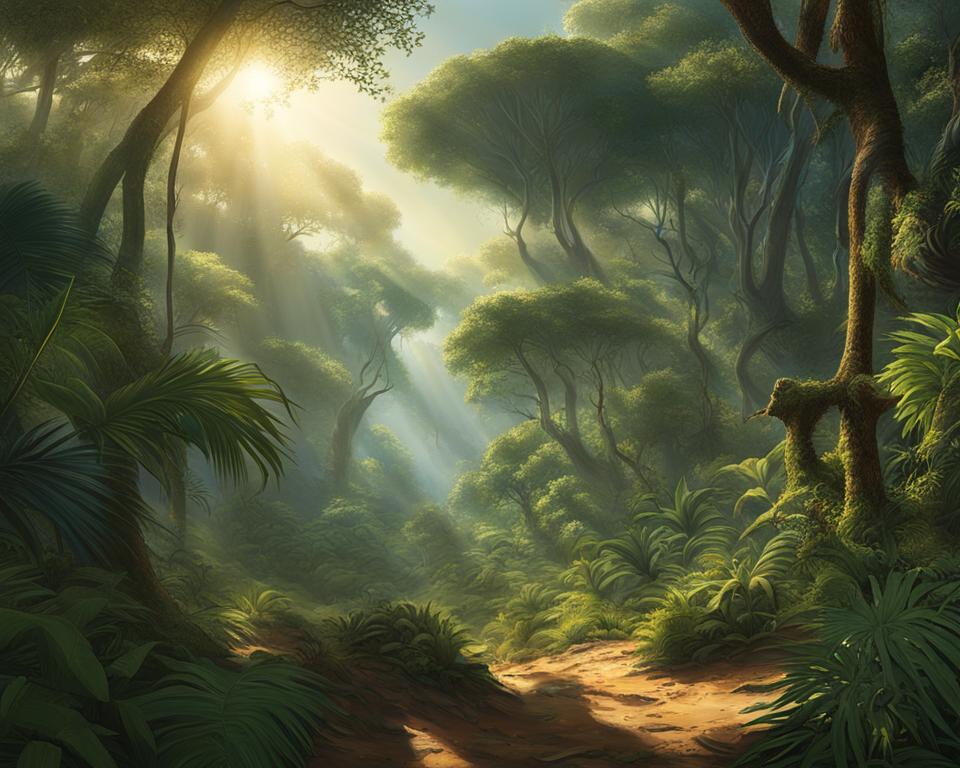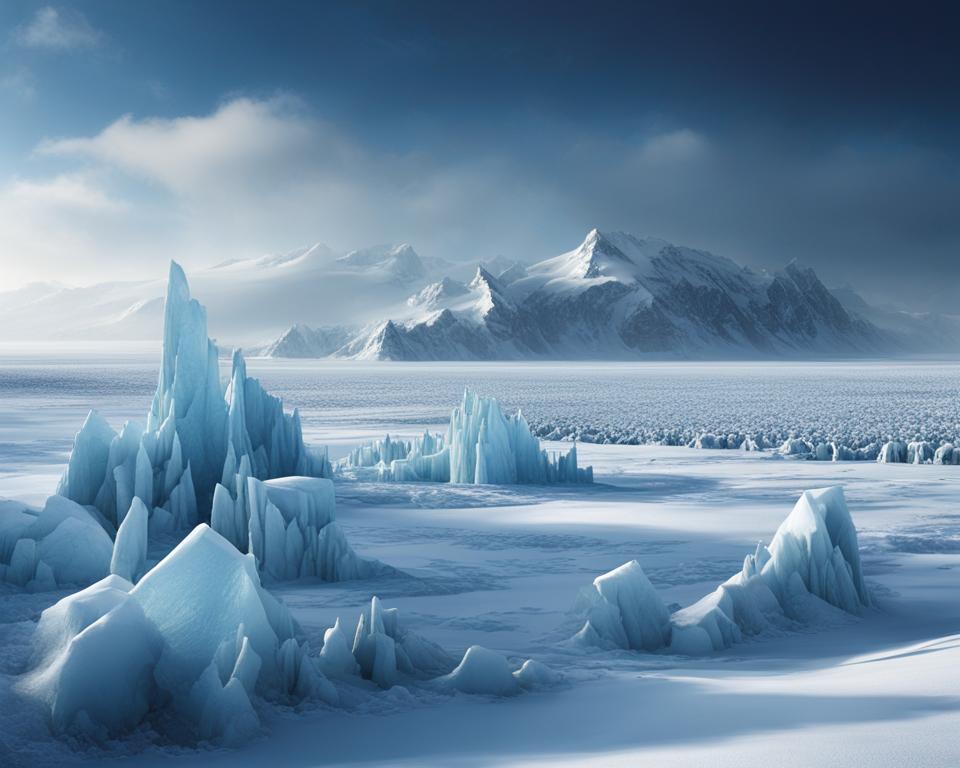Briefly Defining Tundra and Taiga
Welcome to our journey into the frosty frontiers of our planet, where we explore two of the coldest biomes on Earth – the tundra and taiga. These regions are awe-inspiring landscapes, brimming with unique flora, fauna, and abiotic components that make them fascinating subjects for ecological studies. So what exactly is a tundra?
Derived from the Finnish word ‘tunturi’, meaning treeless plain, it’s an area where the subsoil is permanently frozen or in permafrost condition. It’s primarily found in Arctic regions, characterized by strong winds, low temperatures and lack of precipitation.
While it might sound like a bleak snow desert, tundras house an amazing variety of life forms specially adapted to survive these harsh conditions. On the other hand, taigas are more forgiving when it comes to temperature but still demand resilience from its inhabitants due to its long winters.
Also known as boreal forests or snow forests, they form a green girdle around the northern hemisphere just below arctic circles. Dominated by coniferous trees like pine, spruce and fir that can withstand cold winters; taigas too harbor rich biodiversity despite their challenging climate.
Where in the World are Tundra and Taiga Found?
If you’re interested in donning your explorer’s hat and venturing into these icy realms yourself (or maybe just on Google Maps!), let’s first know where to look for them. Tundras encompass some of North America (Northern parts of Alaska & Canada), Europe (Scandinavia & Iceland), Asia (Siberia) stretching across many miles near Arctic Ocean coastlines where extreme cold prevents trees from growing. It’s also seen on tops of mountains above tree line levels globally- affectionately called alpine tundras due to their altitude not latitude.
As for taigas- they encircle world’s largest land biome after deserts and oceans spanning countries like Canada, Russia (occupying almost half its landmass!), Sweden,Norway Finland right down till northernmost parts of USA.These snowy forests account for nearly one-third of world’s total forest cover making them vital carbon sinks besides being home for numerous animal species including wolves,bears deers among others providing timber resources too. Through this article ,we hope bring you closer understanding intricacies these two mighty yet vulnerable biomes how they’re faring face global warming more.Stay tuned!
The Chilly Facts: Understanding the Climate of Tundra and Taiga
Unveiling The Big Freeze: Unpacking the Tundra’s Cold Climate
The tundra is no stranger to unrelenting frigidity. It’s a realm where temperatures frequently plunge below freezing, with the mercury often plummeting to minus 30 degrees Fahrenheit or even lower in winter.
Even summer, its warmest season, barely manages a tepid average of just above 50 degrees Fahrenheit. In fact, this chilling environment is so extremely cold that it hosts a distinctive feature – permafrost.
This permanently frozen layer of soil lurks just beneath the surface and persists all year round. This icy stratum plays an intriguing role in influencing not only the type of vegetation able to survive here but also how life has adapted to thrive amidst this frosty expanse.
A Nippy Niche: Not Quite as Cold, But Still Chilly: The Taiga’s Climate
On shifting our gaze from tundra’s icy plains to taiga’s wooded landscapes, we find a slightly warmer climate – but make no mistake, ‘warmer’ is relative here. The taiga biome endures long winters that are quite severe by most people’s standards but are somewhat more forgiving than those in tundras. Winter temperatures typically hover around minus 20 degrees Fahrenheit but can occasionally hit as low as minus 60 degrees.
However, one might argue that summers in the taiga are nature’s way of presenting some respite from punishing coldness – although they’re short-lived at merely three months! Temperatures can peak at around 70 degrees Fahrenheit during these fleeting months, facilitating an explosion of plant and animal life activity before another relentless winter sets in.
Dress Code for Trees: Vegetation in Tundra Vs Taiga
The Whispering Whites: The Tundra’s Sparse Greens
In the barren landscapes of tundra, where the cold is king and ice his throne, vegetation must fight a constant battle merely to survive. Mother Nature has gifted her green children with special adaptions that enable them to thrive in these harsh environs.
The flora here dons a minimalist attire, dressed mostly in low shrubs, grasses, lichens and mosses. Perennial plants rule the tundra terrains as growing seasons are typically short and harsh.
These hardy plants have adapted with shallow roots to take advantage of the thin layer of soil above the permafrost which harbors most nutrients. In addition to this, they tend to grow close together to protect themselves from cold temperatures and desiccating winds.
Giants Dressed in Green: The Taiga’s Coniferous Couture
Contrastingly, within the borders of taiga biome resides an elegant congregation of tall trees predominantly belonging to coniferous species such as pine, spruce and fir. These evergreen giants stand tall against snow and chilling winds – their needle-like leaves reducing water loss while their dark green color absorbs sunlight for maximum photosynthesis during short winter days. The taiga trees’ cone shape allows them to shed off heavy snow loads without breaking branches whereas thick barks guard their precious sap from freezing.
Deciduous trees like birch or alder also grace this landscape but due its long winters only the toughest survive- making it a realm largely dominated by conifers. Both these biomes though starkly different speak volumes about nature’s ability to adapt and endure.
Critters of Cold Climes: Wildlife in Tundra and Taiga
Surviving on Ice – Wildlife Adaptations in the Tundra
The tundra, often referred to as a polar desert, presents a frigid face that only the hardiest of creatures can truly call home. The extreme cold, coupled with high winds and a scarcity of vegetation, may seem inhospitable to many.
However, the wildlife that inhabit this frosty frontier have developed remarkable adaptations to survive. Creatures such as have grown dense coats made up of stiff guard hairs over soft under-fur to brace against the chill.
Their large hooves support their weight on snow and act like shovels when digging for lichen and plants under the snow. Seals and whales layer themselves with blubber not just for insulation but also buoyancy while swimming in icy waters.
Lemmings, arctic hares, ermines – all wear white cloaks in winter for camouflage against predators while they scurry about in search of food. Polar bears deserve mention as true icons of tundra wildlife resilience.
These giants are insulated by up to four inches (ten centimeters) of blubber beneath a dense fur coat providing both warmth and buoyancy. Aided by large paws that function like snowshoes spreading out their bulk over thin ice or snow while hunting seals.
Furry Friends of the Forest – Animal Life in the Taiga
In contrast to its frosty neighbor, taiga or boreal forest teems with life amidst its towering coniferous trees. From minute insects fluttering about evergreens to majestic moose ambling along forest trails – all contribute vibrant chapters to taiga’s tale.
Moose are quintessential taiga dwellers adapting well to this biome’s long winters by growing thicker skin and hair during colder months. Moose also sport wide hooves aiding them navigate through deep snow looking for food such as bark or twigs from fallen trees.
Squirrels scamper through tree branches stocking up pinecones into caches so they can access food during winter scarcity – an ingenious adaptation! Among other denizens are lynxes with their tufted ears designed for acute hearing which helps them track down small mammals like hares even amidst rustling leaves or snowfall.
Birds too hold fort here quite admirably! Owls use their incredible hearing abilities – thanks largely due to asymmetrically placed ears – enabling them locate prey under blankets of snow!
Woodpeckers employ sturdy beaks chiseling away at tree barks finding insects hiding within. While every creature has evolved uniquely suiting its environment both in tundras or taigas – it is this intrinsic relationship between each animal species & these ecosystems that maintain nature’s delicate balance maintaining biodiversity ensuring survival across generations.
Soil Stories: Examining Soil Composition in Both Biomes
Permafrost and More – Delving into Tundra Soils
If we were to scrutinize tundra soils, we’d find an intriguing phenomenon called ‘permafrost.’ This is a permanently frozen sublayer of soil that can extend hundreds of meters deep. Interestingly, it’s not just the cold that makes tundra soil unique.
It’s also anaerobic, which means it lacks oxygen. This is because the water in the soil freezes and creates a barrier that prevents air from penetrating.
Another fascinating aspect about tundra soil is its layer of moss and lichen, known as ‘cryptogamic soil.’ It’s delicate yet vital for other plants’ survival because it insulates the permafrost and provides nutrients. However, it’s incredibly sensitive to disturbances – human activity or even animal footsteps can damage this layer, with recovery taking several years or even decades.
The Layered Look – Unearthing Facts about Taiga Soils
Taiga soils have their own set of captivating attributes. Unlike tundras, taiga regions have distinctly layered soils called ‘Podzols.’ The topmost layer consists mainly of pine needles and other organic decompositions creating a thick humus.
This humus forms an acidic blanket over the mineral layers beneath it, making nutrient absorption challenging for some species. Beneath this humus lies the eluvial horizon or E-horizon that is leached off nutrients due to strong water movements.
But just below this E-horizon lays B-horizon rich in iron and aluminum compounds named ‘spodic horizon’, giving the Podzols a unique rusty coloration. The nutrient cycling process within Taiga soils involves complex interactions between these layers that create unique conditions for plant growth specific to these boreal forests.
Tales of Human Interaction with these Biomes
Engaging in an exploration of the tundra and taiga, one cannot possibly overlook the human element. While these biomes may seem harsh and inhospitable, they have been home to human communities for centuries, each adapting and evolving unique ways to survive and thrive in these challenging environments.
Humans vs Harshness – Life in the Tundra
The tundra’s harsh climate makes it one of the most challenging places on Earth for humans to live. With temperatures plunging to -50°C during winter months, only a few courageous communities have braved these icy expanses. Inuit communities are a perfect example of this audacious adaptation.
They’ve developed distinctive techniques for survival, such as building igloos from compacted snow blocks that provide insulation against frigid temperatures. Their traditional diet is also a testament to their resilience.
In an environment where plants are sparse, the Inuit rely heavily on hunting marine life such as seals, whales, and fish – all rich sources of fat necessary for surviving extreme colds. Despite its difficulties, life in the tundra instills an appreciation for nature’s majesty in its resplendent aurora borealis or polar daylight phenomena.
Living Amongst Evergreens – Human Habitation in the Taiga
In contrast with its frosty neighbour, the taiga biome has a slightly milder climate making it more hospitable for human habitation. The continental regions of North America and Eurasia see indigenous communities like Sami people in Scandinavia or Evenks in Siberia who’ve carved out their existence among coniferous forests.
These inhabitants adapted themselves by engaging primarily in hunting-gathering lifestyle supplemented by reindeer herding which is akin to agriculture within this hardy biome. Wood from forests served as fuel and timber for housing while fur from hunted animals provided warmth.
Moreover, berries and mushrooms offered some diversity to their diet apart from meat staples. Their life rhythms synchronized with changing seasons showcase a delicate balance between man and nature despite adversities.
Impact of Global Warming on These Frosty Frontiers
Warming Woes for The Frozen Desert – Climate Change & its Impact on The Tundras
Climate change is heating up the frozen expanses of the tundra, resulting in a landscape that’s experiencing some significant shifts. As temperatures increase, permafrost – a permanent layer of soil that remains frozen year-round – is beginning to thaw.
This releases large amounts of carbon dioxide and methane into the atmosphere, potent greenhouse gases which contribute to further global warming. The warming climate also leads to longer growing seasons and changes in vegetation cover.
Certain species like shrubs are starting to thrive where they previously couldn’t survive. While this may sound like a good thing on the surface, it’s actually causing an imbalance in biodiversity as these plants edge out other species, ultimately disrupting delicate ecological networks that have been established over millennia.
Heating Up The Snow Forests – Global Warming’s Effect on The Taigas
In contrast to the tundra’s open landscapes, taigas are dense with coniferous trees. In these snow forests too, global warming is leaving its mark. Rising temperatures are extending the growing season for these coniferous giants, altering their growth patterns and possibly their long-term survival strategies.
Additionally, warmer winters mean fewer days with protective snow cover which exposes trees to harsher conditions and increases susceptibility to diseases and pests. The taiga also faces threats from forest fires amplified by drier conditions due to climate change.
These fires not only destroy massive swaths of forest but also release vast amounts of stored carbon back into the atmosphere as CO2–further fueling global warming in a vicious cycle. With less forest cover absorbing CO2 through photosynthesis, there’s growing concern about how this will tip our planet’s carbon balance towards more rapid climatic shifts.
The Remarkable Resilience of the Tundra and Taiga
As we’ve journeyed through the chilling expanses of tundra and taiga, it’s clear that these frosty frontiers are more than just cold, desolate places. They’re vibrant ecosystems teeming with an array of organisms, each uniquely adapted to survive in their harsh conditions.
They are a testament to the indomitable spirit of life, manifesting itself in the most unlikely places. But as we’ve also seen, these biomes face significant challenges from climate change.
Rising temperatures threaten to disrupt delicate ecological balances that have taken millennia to evolve. Wildlife must contend not just with harsh climates but also with rapidly changing environments.
Resilience Amidst Adversity: The Hope for Tundra and Taiga
Despite the looming threats, there’s reason for optimism. Nature has an incredible capacity for resilience, adaptation and survival—a tenacity exemplified by the hardy species calling tundra and taiga home.
And we can help them by making sustained efforts to mitigate climate change impacts. By understanding these biomes better—acknowledging their unique characteristics and appreciating their importance—we can foster a deeper connection to our planet.
As we embrace sustainable practices in our lives—from reducing emissions to supporting conservation initiatives—we can help ensure that these icy landscapes continue flourishing far into the future. Though seemingly remote and detached from our everyday lives, tundra and taiga are integral parts of Earth’s tapestry—a testament to nature’s power, adaptability, beauty even amidst adversity—and they deserve our care today for tomorrow’s generations.
 Skip to main content
Skip to main content



